Nieuport 17
| Nieuport 17 | |
|---|---|
 | |
| Role | Fighter |
| Manufacturer | Nieuport |
| First flight | January 1916 |
| Introduction | March 1916 |
| Status | Retired |
| Primary users | Aéronautique Militaire Imperial Russian Air Service Royal Flying Corps |
| Number built | 3,600 |
| Developed from | Nieuport 11/16 |
The Nieuport 17 C.1 was a French sesquiplane[fn 1] fighter designed and manufactured by the Nieuport company during World War I. An improved development of the Nieuport 11/16, it was a little larger than its predecessors, and better adapted to the more powerful engine of the N.16. It also incorporated a number of recent innovations, such as the newly-developed Alkan-Hamy synchronization gear, which permitted the use of a fuselage-mounted synchronised Vickers gun, which could safely fire directly through the propeller arc.
At the time of its introduction in March 1916, the type's outstanding manoeuvrability and excellent rate of climb gave it a significant advantage over other fighters on both sides.[1] It was widely used by many operators; entering service with virtually every Allied power, not to mention the German air service. In order to meet the demand from both domestic and foreign customers, the type enjoyed substantial production runs at multiple manufacturing facilities across France, as well as in Italy by Nieuport-Macchi and in Russia at Dux. Unlicenced copies, notably the Siemens-Schuckert D.I and the Euler D.I, were built in Germany.
Various derivatives, improvements, and adaptions were developed. The Nieuport 21, 23 and 17bis, were relatively minor variants,[2] while aerodynamic refinement and a switch to more powerful and lighter Le Rhône rotary engines resulted in the Nieuport 24 and the 27.
Development
Origins
Gustave Delage's appointment as Nieuport's chief designer in January 1914 was followed by a series of sesquiplane designs. Nieuport had been famous for their conventional wire-braced monoplanes, however a series of crashes of service monoplanes due to structural failure, in both France and Britain, lead to an official distaste for the monoplane configuration. In fact, given a structure largely dependent on wire bracing, a biplane structure is inherently stronger than that of a monoplane.[3] The sesquiplane configuration was adopted by Delage as a calculated compromise between the low drag of a monoplane and the superior strength (and lateral control) of a biplane configuration.[4]
The first of Delage's sesquiplanes was the two seat Nieuport 10, which was followed the next year by the Nieuport 11 - this was quickly supplemented by the Nieuport 16, basically, an N.11 with a larger engine. The N.16, especially when armed with a synchronised Vickers gun, suffered from nose-heaviness and poor handling and the company was keen to address these issues.[5]
The result was a slightly larger development of the earlier Nieuport 11, trimmed for the heavier powerplant used by the Nieuport 16 and with larger wings and improved aerodynamic form. It was at first fitted with the 110 hp (82 kW) Le Rhône 9J engine, though later examples used uprated 120 or 130 hp (97 kW) engines.[6]
Design
The Nieuport 17 was a sesquiplane (literally "one-and-a-half plane"), featuring a narrow, single-spar lower wing that was considerably smaller than the upper wing. This arrangement provided several benefits. As well as an improvement in downward visibility for the pilot, there were considerable aerodynamic gains resulting from the relatively wide space between the two sets of wings - producing an above average lift-to-drag ratio, due to the reduction in interplane interference of the sesquiplane format.[4] The heavier components of the fighter, such as the rotary engine, the armament and the fuel and oil tanks were concentrated around the central axis, resulting in the bulk of the aircraft's weight being roughly centred. This was another contributing factor to the 17's high level of manoeuvrability and climb rate.[4]
The fuselage of the 17 was a rectangular-section girder, featuring diagonal wire bracing, steel tubs and plate joints, which were built up around a series of wooden longerons.[7] Towards the rear of the fuselage, the base narrowed as it took on a trapezoidal shape, while the upper surface behind the pilot's position was faired with light formers and longitudinal stringers; a faired headrest was also provided for the comfort of the pilot. The engine was borne by a thick-gauge steel sheet roughly as wide as the fuselage itself, on top of which the engine itself would overhang.[7] The cowling, composed of aluminium, featured strengthened ribs and a pair of inset holes to provide ventilation and egress for the engine's exhaust; it was smoothly merged with the forward fuselage via a series of curved side fairings. Fabric covered the majority of the fuselage aft of the cockpit, which was strengthened by strategically placed plywood panels in some areas.[7]
The wings of the 17 used a relatively uncommon structure, containing widely spaced spars that gave a good angle for load carrying towards the leading edge and resulted in a high degree of stagger, which further reduced interference between the two sets of wings.[8] The ribs, composed of ash flanges and limewood webs, featured cut-outs along their length to lighten them; the ailerons, which were fitted on the top wing only, increased their chord towards the wingtips for improved efficiency. Elevator and rudder controls were provided via conventional cables and pulleys, while the ailerons were actuated by a series of push-pull rods attached to the control column in the cockpit.[9] Prior to take-off, the angle of incidence could be adjusted by ground crew via a single pivot joint arrangement, this would be done to optimise performance to match with the specific payload being carried for a given mission.[9]
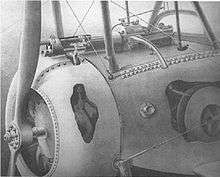
While the single spar lower wing has been credited with helping to give the type its impressive climb rate, it was also prone to flutter,[fn 2] an aerodynamic phenomenon that was not fully understood at the time. Several Nieuport fighters suffered failures of their lower wings due to flutter; this tended to occur during recovery from a prolonged dive. Many British Nieuports were modified at No 2 Aeroplane Supply Depot in an effort to alleviate this problem;[10][4] In later French service, some N.17s had their lower wings replaced with spares taken from newer Nieuport 24s.
Production of the new Alkan-Hamy synchronization gear had permitted the wing-mounted Lewis gun of the 11 and 16 to be replaced with a synchronised Vickers gun, which was mounted on the fuselage to fire through the propeller arc without striking the blades.[6][7] However, the standard Royal Flying Corps (RFC) synchroniser, the Vickers-Challenger gear, was found to be unreliable; and in British service the over-wing Lewis gun was retained. The Lewis gun was installed on the newly-developed Foster mounting, a curved metal rail which allowed the pilot to slide the gun back to change ammunition drums and to clear jams; it also had the advantage of allowing pilots to aim the gun upwards to shoot into the underside of enemy fighters flying above, not an easy tactic, but used to good effect by several ace pilots.[11]
Derivatives
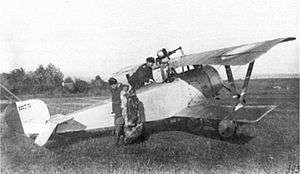
The most important distinction of the Nieuport 21 was the adoption of the lower powered 80 hp Le Rhône 9C engine. This apparently retrograde step permitted stocks of the older engines to be usefully employed for fighter trainers, which did not really need the additional power, and improved fuel and oil economy in training units. Reduced wing loading seems to have made the type favoured as a high altitude bomber escort. In both French and (especially) Russian service the N.21 was commonly used alongside the Nieuport 17 to perform normal fighter roles.[12]
The Nieuport 23 was largely the same aircraft as the 17, differing mainly in modifications deriving from the use of a different machine gun synchronizer — which caused the gun to be offset and the fuel and oil tanks to be rearranged. Rear spar packing pieces were also redesigned. Nieuport 23 fighters were operated by both French and British squadrons alongside N.17s until their replacement by newer Nieuport 24s.[13]
The more powerful 130 horsepower (97 kW) Clerget 9B nine-cylinder rotary engine was used by the Nieuport 17bis, which first appeared late in 1916. The N.17bis had stringers fairing out the fuselage sides compared to the flatter sides on the 17. The major user was the British Royal Naval Air Service, which ordered 30 from Nieuport with 50 more being license-built by the British Nieuport & General Aircraft company. Armament was often augmented to one synchronised Vickers gun and a single Lewis gun mounted over the wing.[14]

A pair of triplanes based on the Nieuport 17 were constructed for testing purposes, one for the French and the other for the British. The narrow chord wings were staggered in an unusual manner, placing the middle wing furthest forward and the top wing furthest aft.[15] No subsequent orders came as a result of these tests; Nieuport later trialled the same layout on the improved Nieuport 17bis, which was tested by the British as well, however this venture also remained a prototype.[15] During flight testing, both types had demonstrated favourable climbing characteristics, but were also found to be relatively tail-heavy.[16]
Several of the experimental Berliner Helicopters, named after their German-American inventor Emile Berliner, were manufactured around Nieuport 23 fuselages, including the 1922 and 1923 versions.
Operational history
.jpg)
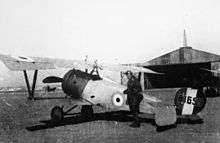
During March 1916, the new Nieuport 17 reached the French front and began to replace the earlier Nieuport 11 and 16 fighters that had been instrumental in ending the Fokker Scourge of 1915. On 2 May 1916, Escadrille N.57 became the first unit entirely equipped with the new model. During the latter part of 1916 and into 1917, the Nieuport 17 equipped every fighter squadron of the Aéronautique Militaire.[1][17] Almost all of the top French aces flew the nimble Nieuport during their flying careers, including Georges Guynemer, Charles Nungesser, Maurice Boyau, Armand Pinsard, René Dorme, Gabriel Guerin and Alfred Duellin.[18]
The type was also used by American volunteers of the Escadrille Lafayette, who transitioned to it from their earlier Nieuport 11s and 16s.
The Nieuport 17 was also ordered by the Royal Flying Corps and Royal Naval Air Service, as it was markedly superior to any of the British fighters available at this time.[17] British units that used the type include Nos 1, 29, 32, 40 and 60 squadrons of the Royal Flying Corps[19]and No 6 of the Royal Naval Air Service - for a time, other units had a few on charge to escort other aircraft.
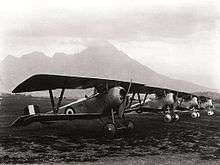
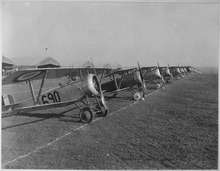
Many British Empire air aces flew Nieuport fighters, including the top Canadian ace Billy Bishop, who received a Victoria Cross while flying it, and Albert Ball, V.C. who often hunted alone in his Nieuport.[20] 'Mick' Mannock VC flew Nieuports early in his career with No 40 Squadron. His VC award reflected his whole combat career – including his time on Nieuports. The top-scoring Nieuport ace was Captain Phillip Fletcher Fullard of No.1 Squadron RFC, who scored 40 kills between May and October 1917, before breaking his leg in a football match.
Numerous Italian aces, such as Francesco Baracca, Silvio Scaroni and Pier Piccio, all achieved victories while flying Nieuport fighters. In Belgium, the 1st and 5th Belgian escadrilles were equipped with the Nieuport 17 and 23. Belgian aces flying the type included Andre de Meulemeester, Edmond Thieffry and Jan Olieslagers.[2]
The Imperial Russian Air Service operated large numbers of Nieuports of all types, including the Nieuport 17, 21 and 23.[2] Being largely reliant on aircraft procured directly from France, there was pressure within Russia to establish and grow a capacity to support the domestic manufacture of such fighters as well. According, efforts were made to produce the type under licence in Russia; however the venture struggled due to a lack of experience in the limited availability of experts to assist.[2] Nonetheless, many of these were operated not only during the Eastern Front of the conflict, but continued to be flown for a time following the Russian Revolution that resulted in the creation of the Soviet Union. Russian Nieuport aces include Alexander Kazakov, who flew the type against the Germans and later against the Bolsheviks as well.[2]
By mid-1917, the Nieuport fighers were losing their superiority to German types such as the new Albatros D.III. In response, the 150 hp SPAD S.VII had begun to replace the Nieuport fighters in French front line squadrons. The British retained their Nieuports until early 1918; until enough Royal Aircraft Factory S.E.5s were available to replace them.[21]
Like the other Nieuport types, during its later life the 17 was operated in large numbers as an advanced trainer. The American Expeditionary Forces purchased 75 Nieuport 17s for training purposes, while the French also operated large numbers as trainers. The French Aviation Maritime operated a single Nieuport 21, which was used for carrier training during 1920 and 1921 aboard the Bapaume, pending the delivery of dedicated carrier aircraft such as the Nieuport-Delage NiD.32RH.[22]
Copies
So impressive were the Nieuport fighters in early 1916 that Idflieg (the German Inspectorate of flying troops) requested that their own aircraft manufacturers produce a copy. Examples of retrieved aircraft, as well as detailed drawings and sketches were provided. In response, the Siemens-Schuckert D.I was produced.[23] This copy, which differed primarily in some minor details, was deemed to be satisfactory and went into production, although in the event the SSW D.I was outdated by the time it had become available, and was employed mainly as an advanced trainer. Another clone of the Nieuport 17 was produced in the form of the Euler D.I, although development work did not proceed beyond a few prototypes.
Other manufacturers, notably Albatros and Pfalz, instead of producing literal copies of the Nieuport, explored the possibilities of incorporating a sesquiplane configuration in their own fighter designs. The Albatros D.II was enhanced in this way to produce the Albatros D.III and D.V - commonly called 'V-strutters' by the RFC to distinguish them from the earlier Albatros fighters. As well as the advantages of this layout these types also inherited the flutter problem,[fn 3] which was never satisfactorily contained, in spite of strengthening. The Pfalz D.III was also a sesquiplane version of a previous biplane fighter, although it featured a more substantial lower wing with two spars that avoided the flutter problems encountered by "single spar" sesquiplanes.[24]
Variants
- 15 meter Nieuport
- A colloquial description of the type based on nominal wing area.
- Nieuport 17
- The standard single-seat fighter biplane model.
- Nieuport 17bis
- Re-engined variant, powered by a 130 hp (95.6 kW) Clerget 9B engine and fitted with fuselage stringers.
- Nieuport 21
- A dedicated high altitude escort fighter/trainer variant; equipped with an 80hp Le Rhône rotary engine, horseshoe cowling and lacking a pilot's headrest.
- Nieuport 23
- Similar to the 17, featuring various structural changes that resulted in the Vickers machine gun being offset if installed. Only other visible difference was changes in cabane rigging.
- Siemens-Schuckert D.I
- While differing in some details, the D.I was largely a copy of the Nieuport 17.
- B.Kh1 (Fighter type 1)
- The Siamese designation for Nieuport 17 and 21.
Survivors and replicas
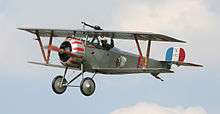
A single original example has survived to the present day, this being Nieuport 23 "5024", which has been preserved and placed on static display in the Belgian Royal Museum of the Armed Forces and Military History in Brussels. However, the Nieuport 17 has also become a popular aircraft for replica builders; dedicated kits for the type have been produced, including both 7/8ths scale and full size, and groups of builders have reproduced entire squadrons of aircraft in this manner. Original drawings, sourced from both the original factory and a German technical report on the fighter, have facilitated the construction of various replicas, such as the example on display in the Canadian War Museum in Ottawa, Ontario, which was built to the original specifications, while many others have used more modern construction, often using metal tubes to replace much of the wooden structure that would have been used on authentic aircraft.
Operators
- Aviation Militaire Belge operated 12 Nieuport 17s[25] and several Nieuport 23s[26]
- Aviação Militar – operated 20 Nieuport 21s[27]
- Chilean Air Force – operated two Nieuport 17s
- Colombian Air Force operated 4 Nieuport 17s.[25]
- Czechoslovak Air Force (Post-war) operated at least one Nieuport 17 and several 23s.[25][26]
- Estonian Air Force operated six Nieuport 17s and 24s[25]
- Finnish Air Force operated a single Nieuport 17[25] and two Nieuport 23s.[26]
- Aéronautique Militaire (Only units whose primary equipment were Nieuport 17, 21 or 23 are included as nearly every French Escadrille operated at least a few)
- Escadrille N 23[28]
- Escadrille N 38[29]
- Escadrille N 62[29]
- Escadrille N 68[29]
- Escadrille N 69[29]
- Escadrille N 76[29]
- Escadrille N 77[29]
- Escadrille N 79[29]
- Escadrille N 87[30]
- Escadrille N 88[30]
- Escadrille N 90[30]
- Escadrille N 91[30]
- Escadrille N 92[30]
- Escadrille N 102[30]
- Escadrille N 153[13]
- Escadrille N 311[1]
- Escadrille N 312[1]
- Escadrille N 387[13]
- Escadrille N 392[30]
- Escadrille N 523[13]
- Escadrille N 581[30]
- Escadrille Lafayette[1]
- Group de Combat GC 11[1]
- Group de Combat GC 12[1]
- Group de Combat GC 13[1]
- Escadrille N 15[28]
- Escadrille N 37[1][29]
- Escadrille N 65[1]
- Escadrille N 67[1]
- Escadrille N 84[1]
- Escadrille N 112[1]
- Escadrille N 124[1][30]
- Group de Combat GC 14[1]
- Group de Combat GC 15[1]
- Group de Combat Chaux[1]
- Escadrille N 49[29]
- Escadrille N 81[1]
- Escadrille N 82[30]
- Aéronautique Navale[1]
- Hungarian Red Air Arm – operated one captured aircraft.[25]
- Corpo Aeronautico Militare approximately 150 built under licence by Nieuport-Macchi
- Luchtvaartafdeeling – 6 aircraft.

.jpg)
operated at least five Nieuport 17s[25] and three Nieuport 21s[26]

- Serviço Aeronáutico Militar - 8 Nieuport Ni.21E1 used as trainers from 1919.[31]

- Royal Romanian Air Force operated 25 Nieuport 17s[25]
- Imperial Russian Air Service purchased a large number of Nieuport 17s from France, and built under licence by Dux[32] who also built 68 Nieuport 21s under licence.[13]
- 1st Fighter detachment[33]
- 2nd Fighter detachment[33]
- 3rd Fighter detachment[33]
- 4th Fighter detachment[33]
- 5th Fighter detachment[33]
- 6th Fighter detachment[33]
- 7th Fighter detachment[33]
- 8th Fighter detachment[33]
- 9th Fighter detachment[33]
- 10th Fighter detachment[33]
- 11th Fighter detachment[33]
- 12th Fighter detachment[33]
- 19th Corps Fighter detachment[34]

- White Army operated an unknown number of Nieuport 17s[32]
- Swiss Air Force operated five Nieuport 23s.[35]
- Royal Siamese Aeronautical Service operated at least one Nieuport 17.[32]
- West Ukrainian People's Republic aviation corps – operated at least three Nieuport 17s,[32] two Nieuport 21s,[13] and seven Nieuport 23s.[26]
.jpg)
- Royal Flying Corps[36] Operated 50 Nieuport 17bis built under licence by Nieuport & General Aircraft, Nieuport 17s, and 80 French built Nieuport 23s[26]
- Royal Naval Air Service operated Nieuport 17, Nieuport 17bis and five Nieuport 21s
- No. 1 Wing[32]
- No. 3 Wing[32]
- No. 4 Wing[32]
- No. 8 (Naval) Squadron
- American Expeditionary Force purchased 175 Nieuport 17s for training purposes, one 17bis,[37] 197 Nieuport 21s[13] and 50 Nieuport 23s.[26]
Specifications (Nie 17)

Data from Those Classic Nieuports,[38] The Nieuport 17[2]
General characteristics
- Crew: one
- Length: 5.80 m (19 ft 0 in)
- Wingspan: 8.16 m (26 ft 9 in)
- Height: 2.40 m (7 ft 10 in)
- Wing area: 14.75 m² (158.8 ft²)
- Empty weight: 375 kg (825 lb)
- Loaded weight: 560 kg (1,232 lb)
- Powerplant: 1 × Le Rhône 9Ja 9-cylinder rotary engine, 82 kW (110 hp)
Performance
- Maximum speed: 177 km/h[39] (96 kn, 110 mph) at 2000m
- Endurance: 1.75 hours
- Service ceiling: 5,300 m (17,390 ft)
- Wing loading: 37.9 kg/m² (7.77 lb/ft²)
- Power/mass: 0.15 kW/kg (0.09 hp/lb)
- Climb to 3,000 m (9,840 ft): 11.5 min
Armament
- Guns:
- (French service) 1 × synchronised Vickers machine gun and sometimes 1 × Lewis gun on upper wing mounting
- (British service) 1 × Lewis gun on Foster mounting on upper wing
- Rockets: 8 Le Prieur rockets (rarely)
Avionics
- 26 cm camera (some aircraft only)[6]
See also
Related development
- Nieuport 11
- Nieuport 24
- Redfern Nieuport 17/24, replica for amateur construction
Aircraft of comparable role, configuration and era
Related lists
References
Footnotes
- ↑ A type of biplane in which one pair of wings is markedly smaller than the other.
- ↑ The single spar on the lower wing was behind the wing's centre of lift, which, because of aeroelastic bending at high speeds caused the lower wing to twist, increasing the angle of attack until the wing stalled, at which point it would spring back to its normal position, repeating the cycle until either the wing snapped or the aircraft's speed was reduced. The exceptional climb rate of the Nieuport meant power on dives were rarely the best choice for re-positioning during a dog fight; as such, pilot training was deemed adequate to resolve the problem, however, that was not so with the Albatros V-strutters, whose heavier weight and lower climb rate meant they were more likely to be put into a high speed power dive.
- ↑ See previous note on flutter.
Citations
- 1 2 3 4 5 6 7 8 9 10 11 12 13 14 15 16 17 18 19 20 21 22 23 24 25 26 27 28 Davilla 1997, p. 383.
- 1 2 3 4 5 6 Andrews 1966, p. 12.
- ↑ Andrews 1966, pp. 3-4.
- 1 2 3 4 Andrews 1966, p. 5.
- ↑ Andrews 1966, pp. 4-5.
- 1 2 3 Davilla, 1997, p.379
- 1 2 3 4 Andrews 1966, p. 6.
- ↑ Andrews 1966, pp. 6-7.
- 1 2 Andrews 1966, p. 7.
- ↑ "Nieuport 17". Canada Aviation and Space Museum. Retrieved 16 September 2012.
- ↑ Andrews 1966, pp. 5-6.
- ↑ Davilla 1997, p. 388.
- 1 2 3 4 5 6 7 Davilla 1997, p. 390.
- ↑ Bruce 1976, pp. 149–153.
- 1 2 Davilla 1997, p. 370.
- ↑ Sanger 2002, pp. 52–54.
- 1 2 Andrews 1966, p. 8.
- ↑ Andrews 1966, p. 10.
- ↑ Cheesman 1960, p. 94.
- ↑ Andrews 1966, pp. 9-10.
- ↑ Andrews 1966, p. 9.
- ↑ Davilla 1997, pp. 388–389.
- ↑ Andrews 1966, pp. 3, 7.
- ↑ Andrews 1966, pp. 7-8.
- 1 2 3 4 5 6 7 8 9 10 11 12 13 14 15 16 17 18 19 20 21 22 23 24 25 26 27 28 Davilla 1997, p. 384.
- 1 2 3 4 5 6 7 8 9 10 11 12 Davilla 1997, p. 391.
- ↑ Davilla 1997, p. 389.
- 1 2 3 4 Davilla 1997, p. 380.
- 1 2 3 4 5 6 7 8 9 10 11 12 13 14 15 Davilla 1997, p. 381.
- 1 2 3 4 5 6 7 8 9 10 11 12 13 Davilla 1997, p. 382.
- ↑ Niccoli 1998, p. 20.
- 1 2 3 4 5 6 7 8 9 10 11 12 13 14 15 16 17 18 Davilla 1997, p. 385.
- 1 2 3 4 5 6 7 8 9 10 11 12 Durkota 1995, p. 9.
- ↑ Durkota 1995, p. 45.
- ↑ Davilla 1997, p. 392.
- ↑ Bruce 1982, p. 333.
- 1 2 3 4 5 6 7 Davilla 1997, p. 386.
- ↑ Bruce 1976, p. 152.
- ↑ Angelucci 1983, p. 42.
Bibliography
- Andrews, C.F. The Nieuport 17 (Aircraft in Profile no. 49). Leatherhead, Surrey, UK: Profile Publications Ltd., 1966. No ISBN.
- Angelucci, Enzo (1983). The Rand McNally Encyclopedia of Military Aircraft, 1914–1980. San Diego, California: Military Press. ISBN 0517410214.
- Apostolo, Giorgio (1991). Aermacchi – from Nieuports to AMX. Milan, Italy: Giorgio Apostolo Editore (GAE).
- Bruce, J.M. (1976). "Those Classic Nieuports". Air Enthusiast Quarterly. Bromley, UK: Pilot Press. 1 (2): 137–153.
- Bruce, J.M. (1982). The Aeroplanes of the Royal Flying Corps (Military Wing). London: Putnam. ISBN 037030084X.
- Bruce, J.M. (1988). Nieuport Aircraft of World War One – Vintage Warbirds No 10. London: Arms and Armour Press. ISBN 0-85368-934-2.
- Bruce, J.M. (1990). Nieuport 17 (and its near relatives) – Windsock Datafile 20. Herts, UK: Albatros Publications. ISBN 978-0948414244.
- Bruce, J.M. (1994). Nieuport Fighters – A Windsock Datafile Special Volumes 1 & 2. Herts, UK: Albatros Publications. ISBN 978-0948414541.
- Čejka, Zdenek (1998). Československé Nieuporty (Czechoslovakian Nieuports). Prague: Historick Sesity.
- Cheesman E.F.(ed.), ed. (1960). 'Fighter Aircraft of the 1914–1918 War. Letchworth, UK: Harleyford Publications.
- Cooksley, Peter (1997). Nieuport Fighters In Action. In Action Aircraft Number 167. Carrollton, TX: Squadron/Signal Publications. ISBN 978-0897473774.
- Davilla, Dr. James J.; Soltan, Arthur (1997). French Aircraft of the First World War. Mountain View, CA: Flying Machines Press. ISBN 978-1891268090.
- Durkota, Alan; Darcey, Thomas; Kulikov, Victor (1995). The Imperial Russian Air Service — Famous Pilots and Aircraft of World War I. Mountain View, CA: Flying Machines Press. ISBN 0-9637110-2-4.
- Franks, Norman (2000). Nieuport Aces of World War 1 – Osprey Aircraft of the Aces 33. Oxford: Osprey Publishing. ISBN 1-85532-961-1.
- Longoni, Maurizio (1976). Nieuport Macchi 11 & 17. Milan: Intergest.
- Nicolli, Riccardo (January–February 1998). "Atlantic Sentinels: The Portuguese Air Force Since 1912". Air Enthusiast. No. 73. pp. 20–35. ISSN 0143-5450.
- Rosenthal, Léonard; Marchand, Alain; Borget, Michel; Bénichou, Michel (1997). Nieuport 1909–1950 Collection Docavia Volume 38. Clichy Cedex, France: Editions Lariviere. ISBN 978-2848900711.
- Sanger, Ray (2002). Nieuport Aircraft of World War One. Wiltshire: Crowood Press. ISBN 978-1861264473.
External links
| Wikimedia Commons has media related to |